Day 66-67, September 20-21, 2008
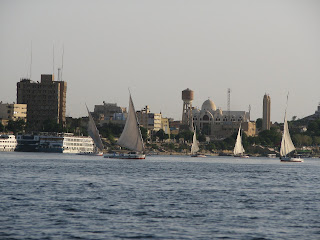
FOOT UPDATE: As diagnosed by a doctor that is part of our tour group, I have definitely broken my foot. I have a fracture of my 5th metatarsal which I can do absolutely nothing for except suck up the pain and wait for it to heal.
====================================================
I have been in Aswan, Egypt for the last two days. Aswan is famous for a few reasons. It is one of most southerly inhabited areas of Egypt, the granite for the Pyramids was excavated from here, and this is the site of the Aswan Dam.
The Aswan Dam was built in the 1960’s with funding from the Soviet Union to help protect the Nile Valley from flooding and to generate electricity. The Nile starts thousands of miles south of here (it’s the longest river on Earth) in the mountains of central Africa. Every year from antiquity through 1970, during the rainy season , the Nile would overflow its banks and flood the entire Nile valley. The ancient Egyptians relied on this to both fertilize and irrigate their crops. Without the annual flooding, there would have been no Egyptian civilization known to us today. It was so important for farming that Imperial Rome relied on Egypt’s wheat to feed its empire. The Nile flooding was so exact that the ancient Egyptian’s named one of their months “Inundation” in honor of and in prediction of the floods.
With modern irrigation and farming techniques, more people living in the Nile Valley, and the occasional disaster, the flooding was much less important to modern Egyptians who needed safety and power so the dam was built. Behind the dam now exists the largest lake in the Mideast following the course that the Nile once ran through Upper Egypt. Lake Nassar is narrow but over 300 miles long and extends into Sudan to the south. It is a big, blue lake surrounded by desert.
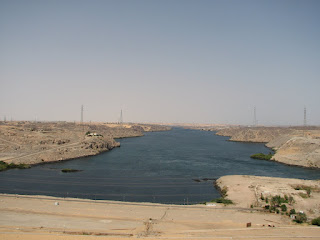
Besides the Aswan Dam, we visited the Philae Temple dedicated to the Goddess Isis, the granite quarry, and the temple of Abu Simbal.
I’ll include some pictures of the quarry and the Philae Temple. It was quite amazing. It was built a few hundred years BC and was used to worship the goddess, Isis. During the early Christian persecutions, it was also used to worship Christ. Amidst the walls of hieroglyphics, one can also make our crosses and early Christian symbols. In the 1960’s, to escape being drowned by the birth of Lake Nassar, the entire temple was cut into pieces and reassembled on higher ground. The same process was used to save the temples at Abu Simbal much farther upstream.
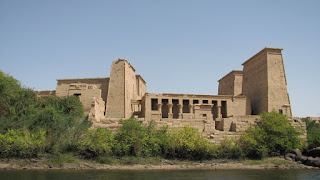
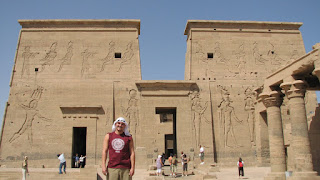
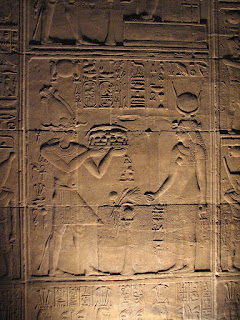
The most impressive thing about the quarry is a giant obelisk that was carved out of the rock but then cracked so was left as is, ruined, over 3000 years ago. It is impressive that the ancient Egyptians were able to precisely cut the rock for all of their monuments without using any metal tools. All of the pyramids and all of the temples of ancient Egypt were quarried using stone to cut stone.
At night, after our tours, we took a long camel ride around the desert for sunset. Out of our entire group, myself, Maria, and Shilpa had the most lively camels. I think I laughed for an hour straight while the camels were racing around with us on their backs. All the while we were doing our best to get a few good pictures and not fall off. My camel was named “Crocodile.” I asked the camel jockey (a legitimate one) if he got that name because he bit like a crocodile. He said no but I am pretty sure that if he could have reached his neck around to me, I’d have been camel cud. Maria’s camel was named Christine. Our camels raced for a while, and while she may tell you differently, my camel defiantly won.
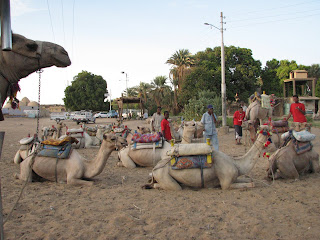


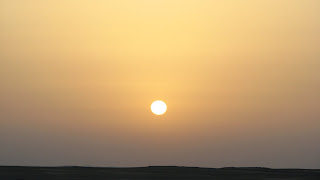
Nubian camel jockeys follow on foot to make sure the camel don’t decide to take off into the desert. When they want the camels to go faster, they yell, “Ya la.” Ya la roughly means, “go” or “get moving” or “come on.” So for and hour, I kept hearing, “Ya la, Christine, ya la.” I can’t wait to see my friends Dan and Christine in New Jersey and let Dan know how to call for his wife in Arabic. Sorry Christine. Ya la, Christine, ya la!
We took the camels to a Nubian village for dinner. The part of Egypt, in antiquity, was the country of Nubia, the perennial enemies of Egypt. The locals were and are referred to as Nubians. They have black skin, their own language and live in one of the more beautiful, if not hot, areas of modern Egypt. Saturday, the temperature hit 105+ but with zero humidity here in the desert.
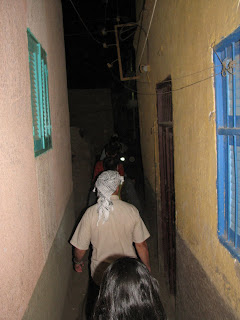
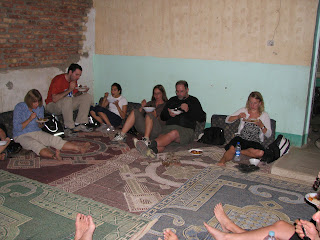
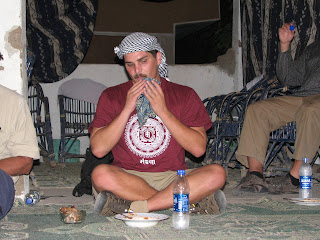
Yesterday, my last full day in Aswan, we took a trip down to the temples of Abu Simbal. Abu Simbal is the large temple complex built by Ramses II, the Moses Pharoah, and one of the longest reigning and most powerful of ancient Egypt. Ramses is probably the most well-known Pharaoh, next to King Tut, and it is his image that is often used in modern media to depict an Egyptian Pharaoh.
We had to leave very early for Abu Simbal with our wake-up call at 3:15 AM. It is about 150 miles south of Aswan, deep into the Egyptian desert. The reason that you have to leave so early is that there are set caravan times to go to the temple. Since it is relatively close to the Sudanese border, one of the most dangerous places on Earth, all tourist buses have to drive together and need a security escort. The day after we were there, 11 tourists were kidnapped by some Sudanese in another border area of Egypt. They were off on their own in a place that they probably shouldn’t have but I am still glad that we had our security convoy.
There are two temples at the site: one dedicated by Ramses II to the sun god Ra and one by his wife Neferteri to the goddess, Mut. Both are over 3500 years old and amazingly preserved. In much of the temple, the hieroglyphs are so well preserved that you can still see the original paint on them. This would be impressive no matter what but even more so if you consider that the entire temple has been moved 50 meters up and several hundred meters down from its original location which now sits at the bottom of Lake Nassar. When the Aswan Dam was being built, Egypt and UNISCO organized a worldwide international coalition of archaeologists and engineers to document and save as many of the Nubian and Egyptian sites as possible that would be flooded by the new lake.
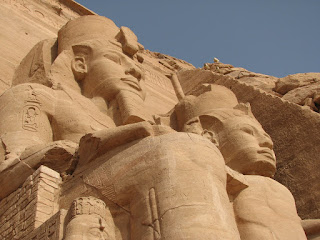

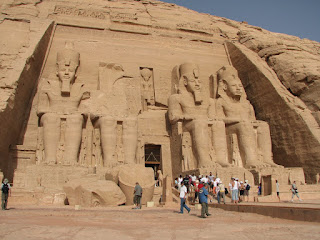
Abu Simbal, over the course of several years and with the Nile rising more everyday, was cut into pieces and perfectly reconstructed in its new location. It is so precisely reassembled that if you had visited in the 1950’s and then again today, you may have no clue that you are in a completely different spot.
The temple was great and totally worth the early wake-up but it did make for a very sleepy ride back to Aswan.
That night, we went through a crazy market and did some shopping. I had a great few days in Aswan.
Ya la, Christine, ya la!
She’s going to kill me.
FOOT UPDATE: As diagnosed by a doctor that is part of our tour group, I have definitely broken my foot. I have a fracture of my 5th metatarsal which I can do absolutely nothing for except suck up the pain and wait for it to heal.
====================================================
I have been in Aswan, Egypt for the last two days. Aswan is famous for a few reasons. It is one of most southerly inhabited areas of Egypt, the granite for the Pyramids was excavated from here, and this is the site of the Aswan Dam.
The Aswan Dam was built in the 1960’s with funding from the Soviet Union to help protect the Nile Valley from flooding and to generate electricity. The Nile starts thousands of miles south of here (it’s the longest river on Earth) in the mountains of central Africa. Every year from antiquity through 1970, during the rainy season , the Nile would overflow its banks and flood the entire Nile valley. The ancient Egyptians relied on this to both fertilize and irrigate their crops. Without the annual flooding, there would have been no Egyptian civilization known to us today. It was so important for farming that Imperial Rome relied on Egypt’s wheat to feed its empire. The Nile flooding was so exact that the ancient Egyptian’s named one of their months “Inundation” in honor of and in prediction of the floods.
With modern irrigation and farming techniques, more people living in the Nile Valley, and the occasional disaster, the flooding was much less important to modern Egyptians who needed safety and power so the dam was built. Behind the dam now exists the largest lake in the Mideast following the course that the Nile once ran through Upper Egypt. Lake Nassar is narrow but over 300 miles long and extends into Sudan to the south. It is a big, blue lake surrounded by desert.
Besides the Aswan Dam, we visited the Philae Temple dedicated to the Goddess Isis, the granite quarry, and the temple of Abu Simbal.
I’ll include some pictures of the quarry and the Philae Temple. It was quite amazing. It was built a few hundred years BC and was used to worship the goddess, Isis. During the early Christian persecutions, it was also used to worship Christ. Amidst the walls of hieroglyphics, one can also make our crosses and early Christian symbols. In the 1960’s, to escape being drowned by the birth of Lake Nassar, the entire temple was cut into pieces and reassembled on higher ground. The same process was used to save the temples at Abu Simbal much farther upstream.
The most impressive thing about the quarry is a giant obelisk that was carved out of the rock but then cracked so was left as is, ruined, over 3000 years ago. It is impressive that the ancient Egyptians were able to precisely cut the rock for all of their monuments without using any metal tools. All of the pyramids and all of the temples of ancient Egypt were quarried using stone to cut stone.
At night, after our tours, we took a long camel ride around the desert for sunset. Out of our entire group, myself, Maria, and Shilpa had the most lively camels. I think I laughed for an hour straight while the camels were racing around with us on their backs. All the while we were doing our best to get a few good pictures and not fall off. My camel was named “Crocodile.” I asked the camel jockey (a legitimate one) if he got that name because he bit like a crocodile. He said no but I am pretty sure that if he could have reached his neck around to me, I’d have been camel cud. Maria’s camel was named Christine. Our camels raced for a while, and while she may tell you differently, my camel defiantly won.
Nubian camel jockeys follow on foot to make sure the camel don’t decide to take off into the desert. When they want the camels to go faster, they yell, “Ya la.” Ya la roughly means, “go” or “get moving” or “come on.” So for and hour, I kept hearing, “Ya la, Christine, ya la.” I can’t wait to see my friends Dan and Christine in New Jersey and let Dan know how to call for his wife in Arabic. Sorry Christine. Ya la, Christine, ya la!
We took the camels to a Nubian village for dinner. The part of Egypt, in antiquity, was the country of Nubia, the perennial enemies of Egypt. The locals were and are referred to as Nubians. They have black skin, their own language and live in one of the more beautiful, if not hot, areas of modern Egypt. Saturday, the temperature hit 105+ but with zero humidity here in the desert.
Yesterday, my last full day in Aswan, we took a trip down to the temples of Abu Simbal. Abu Simbal is the large temple complex built by Ramses II, the Moses Pharoah, and one of the longest reigning and most powerful of ancient Egypt. Ramses is probably the most well-known Pharaoh, next to King Tut, and it is his image that is often used in modern media to depict an Egyptian Pharaoh.
We had to leave very early for Abu Simbal with our wake-up call at 3:15 AM. It is about 150 miles south of Aswan, deep into the Egyptian desert. The reason that you have to leave so early is that there are set caravan times to go to the temple. Since it is relatively close to the Sudanese border, one of the most dangerous places on Earth, all tourist buses have to drive together and need a security escort. The day after we were there, 11 tourists were kidnapped by some Sudanese in another border area of Egypt. They were off on their own in a place that they probably shouldn’t have but I am still glad that we had our security convoy.
There are two temples at the site: one dedicated by Ramses II to the sun god Ra and one by his wife Neferteri to the goddess, Mut. Both are over 3500 years old and amazingly preserved. In much of the temple, the hieroglyphs are so well preserved that you can still see the original paint on them. This would be impressive no matter what but even more so if you consider that the entire temple has been moved 50 meters up and several hundred meters down from its original location which now sits at the bottom of Lake Nassar. When the Aswan Dam was being built, Egypt and UNISCO organized a worldwide international coalition of archaeologists and engineers to document and save as many of the Nubian and Egyptian sites as possible that would be flooded by the new lake.
Abu Simbal, over the course of several years and with the Nile rising more everyday, was cut into pieces and perfectly reconstructed in its new location. It is so precisely reassembled that if you had visited in the 1950’s and then again today, you may have no clue that you are in a completely different spot.
The temple was great and totally worth the early wake-up but it did make for a very sleepy ride back to Aswan.
That night, we went through a crazy market and did some shopping. I had a great few days in Aswan.
Ya la, Christine, ya la!
She’s going to kill me.
No comments:
Post a Comment